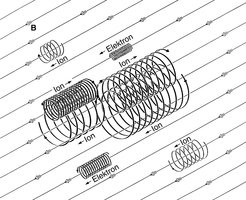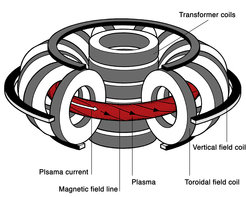Magnetic confinement

Charged particles – ions and electrons – are forced in a magnetic field into circular and helical orbits around the magnetic field lines. The particles are thus tied to the field lines. On the other hand, they are able to move freely in the longitudinal direction of the lines. In a suitably shaped magnetic field cage it is therefore possible to confine a plasma and keep it away from material walls.

Particularly suitable are magnetic fields circularly closed upon themselves. This alone is not sufficient, however, to achieve particle confinement. As the field strength in a purely ring-shaped field decreases to the outside, the particles would quickly be pushed to the wall. First the field lines have to be twisted to allow permanent confinement of the plasma.
The field lines enclosing the ring set up "magnetic surfaces", nested in one another like layers of onion, in which the density and temperature of each are constant. The absence of a radial field component, which would lead the plasma particles to the outside, is the prerequisite for magnetic plasma confinement.

